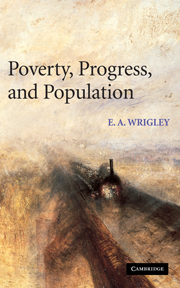Book contents
- Frontmatter
- Contents
- List of figures
- List of tables
- Acknowledgements
- Introduction
- PART I The wellsprings of growth
- PART II Town and country
- PART III The numbers game
- 12 Explaining the rise in marital fertility in England in the ‘long’ eighteenth century
- 13 No death without birth: the implications of English mortality in the early modern period
- 14 The effect of migration on the estimation of marriage age in family reconstitution studies
- 15 Demographic retrospective
- Bibliography
- Index
13 - No death without birth: the implications of English mortality in the early modern period
Published online by Cambridge University Press: 23 December 2009
- Frontmatter
- Contents
- List of figures
- List of tables
- Acknowledgements
- Introduction
- PART I The wellsprings of growth
- PART II Town and country
- PART III The numbers game
- 12 Explaining the rise in marital fertility in England in the ‘long’ eighteenth century
- 13 No death without birth: the implications of English mortality in the early modern period
- 14 The effect of migration on the estimation of marriage age in family reconstitution studies
- 15 Demographic retrospective
- Bibliography
- Index
Summary
It is obvious that for most of human history fertility and mortality must have been at closely similar levels. For the former to have fallen short of the latter consistently would have meant extinction, while the opposite case could not have long continued because of the impossibility of increasing food supplies other than very slowly. Man is a slow-breeding animal and, therefore, human mortality was always at a far lower level than in most other animals. There is no reason to suppose that crude birth rates in any large population consistently exceeded about 50 per 1,000. Equally, there can be no reason to believe that crude death rates ever significantly exceeded this level. In individual years and in exceptional circumstances far higher death rates occurred, but even when such mortality surges occurred the usual situation must have been very different. This in turn implies that expectation of life at birth can seldom have been much less than 20 years at birth, and that where this was so, the gross reproduction rate was in the range 3.0–3.5. Those women who survived to the end of the childbearing period bore about seven children on average.
An expectation of life at birth of 20 years represents a drastically more severe mortality regime than that experienced today when expectation of life at birth (e0) is about 75 years in advanced communities, but even so it is possible to exaggerate the uncertainty of life in such circumstances. Under the age of one, and to a lesser degree under the age of five, life is desperately hazardous.
- Type
- Chapter
- Information
- Poverty, Progress, and Population , pp. 351 - 366Publisher: Cambridge University PressPrint publication year: 2004



